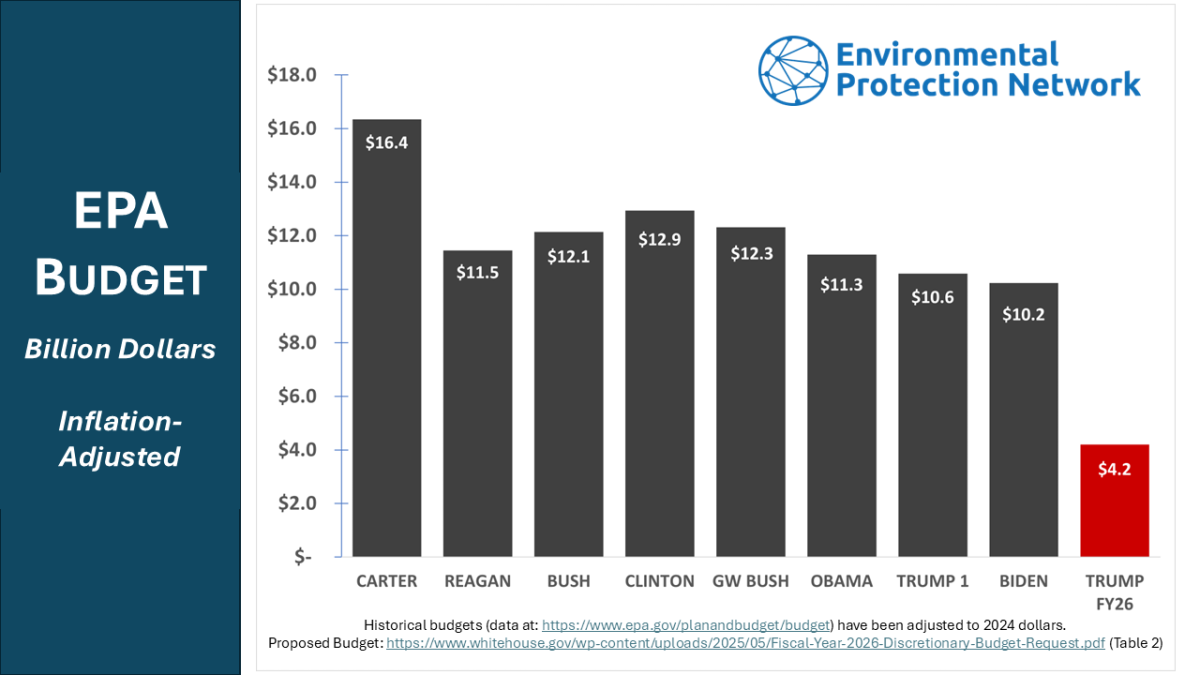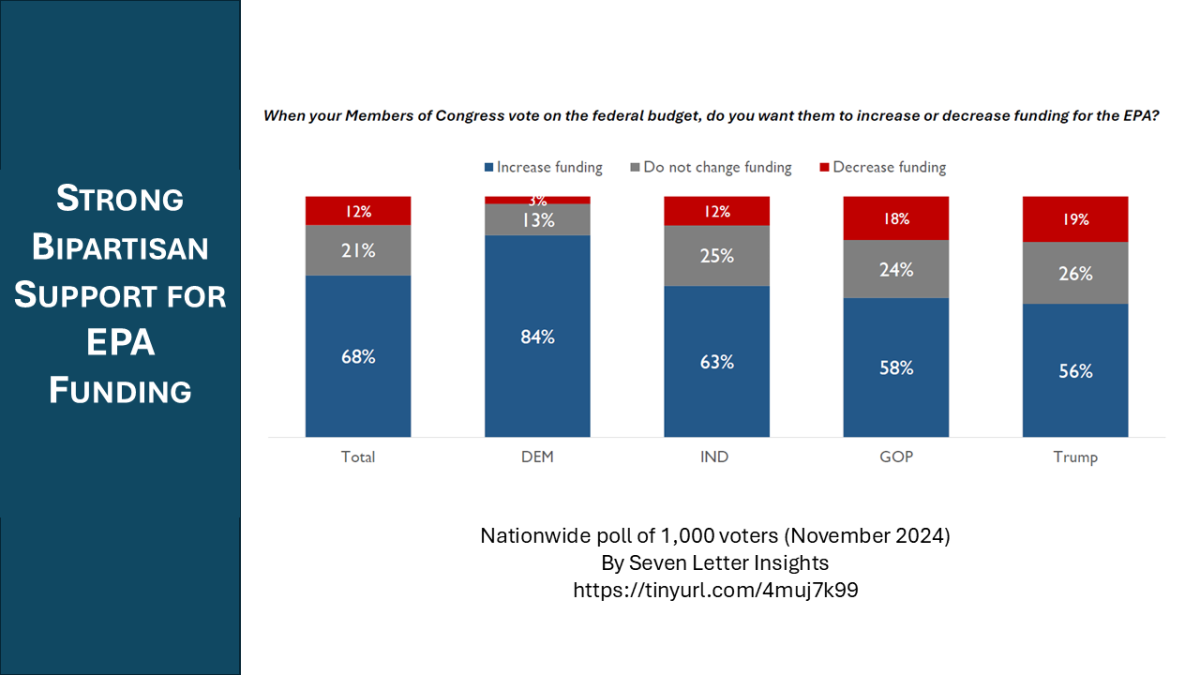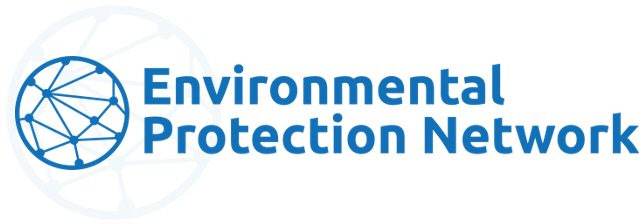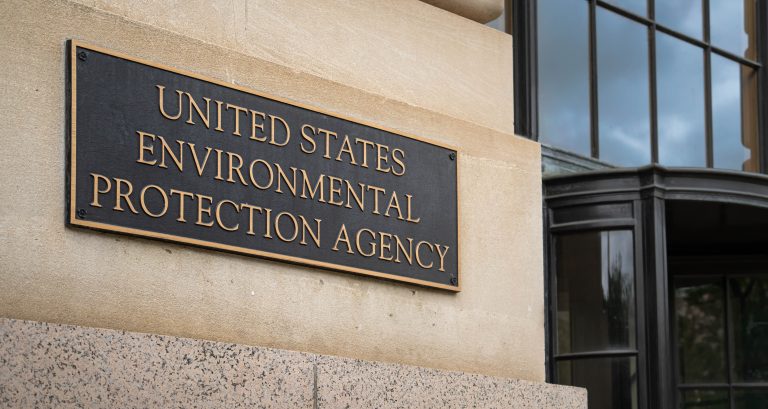|
MEDIA ADVISORY |
Contact: Aaron Bharucha, Public Relations Associate |
Proposed 55% cut to EPA Is a Wrecking Ball that Endangers the Air We Breathe and the Water We Drink
The Environmental Protection Network will host a press conference on Monday, May 5 at 11:00 a.m. EST. RSVP here.
WASHINGTON, D.C. — The Environmental Protection Network (EPN) strongly condemns the president’s proposed FY2026 budget for EPA, which would inflict severe damage on EPA’s ability to protect vulnerable communities, safeguard public health, and preserve the environment.
“This is a reckless and short-sighted proposal that will lead to higher levels of toxic pollution in the air we breathe and water we drink across the nation,” said Michelle Roos, Executive Director of the Environmental Protection Network. “This is a wrecking ball approach that would gut America’s frontline defense for protecting people’s health and environment.”
Press Conference
The Environmental Protection Network will host a press conference on Monday, May 5 at 11:00 a.m. EST. Former EPA officials will speak to how the president’s budget proposal will weaken EPA’s ability to protect public health and the environment. You will find the Zoom link in the RSVP form.
Part of a Larger Plan to Tear Down EPA
President Trump’s proposal to cut EPA by $5 billion annually, approximately 55% of the EPA’s FY2025 budget, would require mass layoffs at the agency and cripple its core functions, including enforcing air and water quality standards, addressing toxic waste sites, and advancing environmental justice initiatives.
“The cuts are part of a broader administration agenda to put the interests of large polluters ahead of public health and the environment,” said Roos. “They have already halted enforcement of the Clean Air Act and other bedrock environmental laws and eliminated environmental justice programs and funding that ensure everyone has the right to breathe clean air and drink clean water.”
EPA Administrator Lee Zeldin has timed this news to coincide with a buyout offer in the hopes that thousands of EPA staff will voluntarily head for the exits and not wait to see what congress does.
“EPA staff fight every day for our health, and it’s our turn to fight for them,” said Roos. “When the next toxic disaster strikes, who will answer the phone and respond?”
Largest Proposed EPA Budget Cut in History
The proposed EPA budget would by far be the largest in the agency’s history (see graphic below). It amounts to a reduction by more than half from current levels and would be a cut of more than 60% below EPA funding levels under presidents Reagan and George W Bush (on an inflation adjusted basis). This would reduce EPA funding to levels not seen since the agency’s formative years in the early 1970s.

Strong Bipartisan Opposition to EPA Funding Cuts
“Americans overwhelmingly support EPA’s mission, and the public must speak up and tell congress to stop these attacks on public health,” said Roos.
According to a nationwide poll 68% of Americans want Congress to INCREASE funding for EPA, compared to only 12% that want EPA’s funding decreased. The number of Trump voters who want Congress to increase EPA funding (56%) is three times as large as the number of Trump voters who want Congress to decrease EPA funding. During his campaign, Trump promised voters that he would deliver clean air and clean water but never said he would try to gut EPA’s budget.

Stripping States of Vital Health and Environmental Funding
The potential $2.46 billion cut to the Clean Water and Drinking Water State Revolving Funds (SRFs) represents an historic rollback of federal investment in local and state water infrastructure. These funds are foundational to modernizing aging drinking water systems, preventing lead contamination, and safeguarding drinking water access for millions of Americans. Eliminating or drastically reducing SRF funding at this scale risks exacerbating public health crises, disproportionately harming low-income and underserved communities.
Moreover, the $1 billion reduction in Categorical Grants removes essential resources that enable state and local governments to enforce clean air, safe drinking water, and hazardous waste regulations. Far from being a “crutch,” these grants provide the baseline capacity for states to uphold federally mandated protections. The withdrawal of federal support signals an abdication of responsibility and will result in widespread backsliding that will worsen the air we breathe and the water we drink.
Silencing Science
The proposed $235 million (45%) cut to EPA’s Science Office (Office of Research and Development, or ORD) undermines the scientific foundation of environmental policymaking. EPA’s science office serves as the agency’s backbone for protecting Americans from air and water pollution, toxic chemicals and emerging threats such as PFAS forever chemicals and microplastic.
“EPA’s science office exists to meet the moment when unexpected environmental crises strike and to lead the way on threats before they escalate,” said Jennifer Orme-Zavaleta, Ph.D, former Principal Deputy Assistant Administrator of ORD and former EPA Science Advisor. “Whether responding to chemical spills, natural disasters or bioterrorism, EPA’s science office provides the rapid scientific expertise and tools that protect communities in real time. It is also at the forefront of addressing complex challenges like harmful algal blooms, wildfire smoke, threats to drinking water safety and climate-driven risks. Weakening EPA’s science office would leave the nation without the scientific readiness and innovation needed to respond to today’s threats, and tomorrow’s.”
“This is yet another example of the administration prioritizing the interests of major polluters over the health of children and other vulnerable people,” said Michelle Roos, Executive Director of Environmental Protection Network. “They know that science stands in the way of their rollback agenda, and their only defense is to keep Americans in the dark.”
Environmental Injustice
The elimination of EPA’s Environmental Justice (EJ) programs, framed in politically charged language, is a direct attack on decades of bipartisan recognition that environmental burdens are not distributed equally. Environmental Justice programs ensure that historically marginalized and frontline communities, who face higher exposure to pollutants and have less access to environmental protections, have a voice and receive targeted investments. Eliminating this program disregards real, measurable inequities and abdicates the federal government’s commitment to fairness and public health.
Congress Must Reject These Reckless Cuts
This budget reflects a systematic effort to hollow out the EPA’s capacity to safeguard people’s health and the environment. It places the burden of environmental protection on under-resourced states, silences science, and opens the door for polluters to act without accountability. The Environmental Protection Network urges Congress to reject these harmful cuts and to restore funding to EPA at levels that reflect the scale of the environmental and public health challenges we face.
“If this budget were enacted, it would mean more air pollution, more water pollution, more contaminated sites that won’t be cleaned up and put to productive use generating local jobs and taxes. Farmers, businesses large and small, industry, state and local government would all feel the effects of this budget and its assumption that states and others will be able to do the job of protecting health and the environment themselves,” said Janet McCabe, former EPA Deputy Administrator. “This reflects a fundamental misunderstanding of the laws that Congress has enacted starting in the 1970s that establish a partnership between the state and federal governments for environmental protection. You cannot cut EPA’s budget this drastically without significantly reducing the quality of the country’s air, water, and land.”
###
ABOUT THE ENVIRONMENTAL PROTECTION NETWORK
Founded in 2017, the Environmental Protection Network harnesses the expertise of more than 650 former EPA career staff and confirmation-level appointees from Democratic and Republican administrations to provide the unique perspective of former scientists and regulators with decades of historical knowledge and subject matter expertise.

